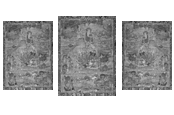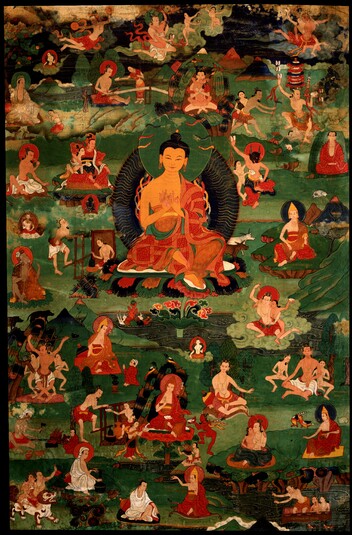
Item: Indian Teacher - Nagarjuna
| Origin Location | Tibet |
|---|---|
| Date Range | 1700 - 1799 |
| Lineages | Gelug |
| Size | 71.12x45.72cm (28x18in) |
| Material | Ground Mineral Pigment on Cotton |
| Collection | Rubin Museum of Art |
| Catalogue # | acc.# P2000.14.3 |
Nagarjuna, Arya (Tibetan: pag pa lhu drup. Bibliographic details): founder of the philosophical system known as Madhyamaka, the Middle Way School. His exact dates are not known but it is generally believed he lived around the time of the 1st and 2nd centuries C.E. The Problem of the Historical Nagarjuna Revisited by Ian Mabbett. The Journal of the American Oriental Society, Vol.118 No.3 (July 1998).

Vajradhara | Nagarjuna | Atisha
Thirty-one of the Eighty-four Mahasiddha The listing of the mahasiddha begins at the top right of the composition and move clockwise around the painting. The non-sequential numbers below correspond to the sequential list of the siddhas according to the System of Vajrasana.
1. Nagarjunagarbha: the large central image in the composition; a seated monk with a hood of snakes.
40. Kongkana: flying in the sky with a consort.
24. Krishnacharya: in a dancing posture with parasols and drums floating above.
16. Naropa: light skinned and embracing a partner in sexual embrace.
17. Kotalipa: holding a hoe in both hands with an attendant behind.
19. Lawapa: a monk seated inside a grass hut.
30. Marmelha: a dancing figure with a buffalo head. (Inscription reads ma he pa).
29. Nagabodhi: a seated monk with a yellow hat.
31. Dakipa: flying on a cloud holding arrows in the right hand; with a consort.
41. Pakapala: semi-naked with two naked consorts.
32. Jetari: seated with the left arm extended to the side; White Manjushri above.
45. Dharmakirti: a seated monk wearing a yellow hat.
53. Karupaka: a bent over boatman with two passengers.
44. Sutaloki: seated with a consort wrapped in a dark blanket.
52. Having the Strength of the Clouds (sprin gyi shugs can): a monk with a yellow hat.
49. Padmakara: a monk in red robes with an orange hat atop a large lotus blossom.
51. Minarapa: seated wearing a white garment and the left arm forward.
48. Nilapa: a figure wearing white garments, kneeling above a pot, dying cloth blue.
50. Singhapa: a siddha and consort riding a white snow lion.
42. Tampaka: a blacksmith in front of an anvil and bellows.
39. Virayapa: pressing oil with a manual machine; a dakini holds a skullcup.
27. Shawaripa: standing with a bow above the head; two consorts at the sides.
38. Suvarnadvipa: a monk with a yellow hat seated on a red mat.
25. Pig Herder (phag tshang pa): in a squatting posture, elderly with brown clothes.
23. Telopa: a siddha with an attendant works a sesame oil pressing machine.
18. Tantrala: a youthful figure atop a deerskin smells a flower.
15. Indrabhuti: seated in rich garments and a flower crown accompanied by a consort.
20. Chandragomi: seated and clad in white with the hand raised; White Tara above.
28. Darikapa: seated at a loom and offered a cup to drink by a lady.
26. Bhadrapa: flying in th sky and playing a pair of cymbals.
6. Sararuhavajra: flying in the sky with a consort and two attendants.
Jeff Watt 12-2005
Collection of Rubin Museum of Art: Painting Gallery 9
Subject: Indian Scholars (Buddhist)
Indian Adept: Eighty-four Mahasiddhas (Numbered Systems)
Indian Scholar: Nagarjuna & Eighty-four Mahasiddhas
Painting Set: Indian Adepts - Panchen Lama
Indian Scholar: Nagarjuna Depictions
Indian Scholar: Nagarjuna Main Page
Indian Scholar: Nagarjuna (Eighty-four Mahasiddhas)
Indian Adept: Five Contexts of Depiction
